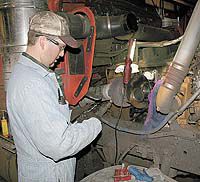| Landon Jacobson works on a truck brought to his shop for repairs. The Landon’s Diesel Service operator indicates that drivers complain a lot about the prices of fuel even though the cost has recently started to ease. |
Many Carbon County consumers and local residents in the trucking industry remember when diesel fuel cost considerably less at the fuel pumps than gasoline did.
“It was a good time to be an independent trucker,” said Dave Keller as he fueled up his tractor trailer rig at a local truck stop on Monday. “In the 1970s and ’80s, prices were always well below what gasoline was. The cost of this stuff I am putting in my tank is ripping the heart out of the trucking business.”Keller, an independent trucker who hails from Moberly, Mo., said that in all of his 35 years in the trucking business he had never seen anything like the last year.
“Increased demand has driven the prices up,” indicated Keller as he finished filling the tank and headed to pay for the fuel. “There are a lot more pickups and even cars on the road using diesel now.”
According to national sources, there are more vehicles traveling on the road using diesel and demand for the fuel is definitely up across the United States.
But while most Americans and local residents tend to dwell on that fact, people may fail to recognize that the expansion of diesel use is worldwide, not just in the United States.
While the cost of diesel has gone down from more than $3 per gallon in the last few weeks, it has not fallen as far as gasoline prices have.
Presently, the national average for diesel is hovering around $2.50 per gallon, 30 cents more than the average price of gasoline and 40 cents higher than it was a year ago in December..
In the Carbon County area, diesel is currently selling for between $2.31 and $2.53 while unleaded gasoline is going for as low as $2.13 per gallon.
Prices for gas are considerably cheaper along the Wasatch Front, with some retail store chains offering discounts to customers buying groceries at stores.
The chains are selling unleaded gasoline for as low as between $1.70 and $1.80 per gallon. Diesel, however, is still proportionately higher.
Local sources also indicate that the cost is a major concern to truckers of all types.
“They talk about the price of diesel a lot,” noted Landon Jacobson, the owner of Landon’s Diesel Service in Price. “The prices are starting to go down a little but it is still a main topic of conversation.”
Diesel fuel prices have always been at the mercy of winter more than gasoline prices have.
Diesel is a distilled fuel similar to heating oil. Since diesel is derived from the breakdown of oil, the prices have always been forced up with the cold weather comes. While not many people in the local area use heating oil, in some parts of the northeast heating oil is the main way to heat homes and businesses. Supplies of these kinds of fuels are tight, reports the Department of Energy, and that of course, based on supply and demand keeps the price up.
The storms that devastated many refineries on the gulf coast in August and September reduced refining capacity for all fuels and that came at a time when diesel fuel was already up against the wall as far as supplies go. Americans driving their big Ford, Chevy and Dodge pickups may have made these supplies somewhat tighter, but the real demand increase has not come because of those vehicles being used in the United States, but more because of increasing demand in China and India, where economies are booming and businesses are demanding more energy.
According to a report in the Wall Street Journal on Nov. 28, when the price went up for gasoline American refineries responded by producing more and more. But because the refineries in this country are set up to produced a lot of gasoline. Their production of diesel is very limited. And new refineries are not under construction, in fact there hasn’t been a new major refinery built in years, while many have worn out or been decommissioned.
The demand for diesel is rising more than it is for gasoline, both domestically and world wide. In fact many countries have it much worse than the United States, because despite short supplies, American users can almost always get the fuel, while in many foreign countries it’s availability is sometimes questionable no matter what the price.
In China many of the companies that have set up factories there to produce the cheap goods that Americans want to buy are having a hard time finding transports from manufacturing points to the ship yards. Some have resorted to using small gasoline powered vans, run by privateers to clear out full warehouses, a proposition that is much more expensive for the companies that make the goods.
Shortages in Europe, where many more vehicles, particularly cars, run on diesel, are causing long lines. In some cases drivers are lining up as early as 4 a.m. in the morning to be in line for a fuel station that opens at 7 a.m.
In Australia, farmers are considering putting in large storage tanks, fearing that at planting and harvest time they will not have enough fuel to put their crops in the ground and then get them ready for market.
While the United States refines much of it’s own gasoline, it also imports some directly. Diesel on the other hand, obviously can’t be imported when the rest of the world is scrounging for it. So suppliers from other countries cannot help with the impending crisis in America.
Next year new environmental regulations go into effect concerning sulphur in diesel fuel. How that could affect supplies remains to be seen, but it certainly will not increase supplies.

